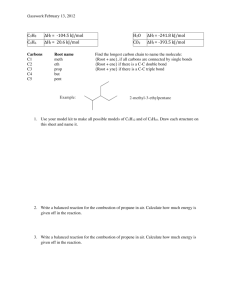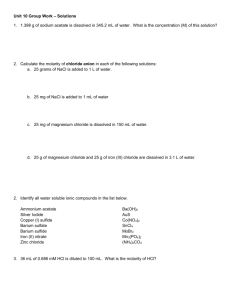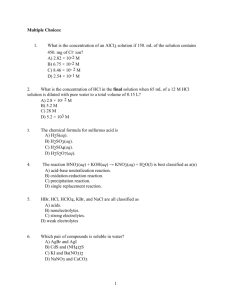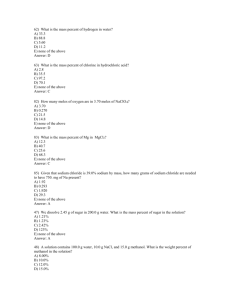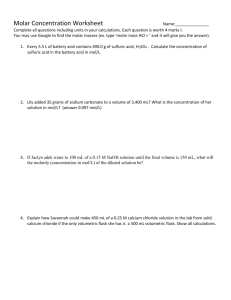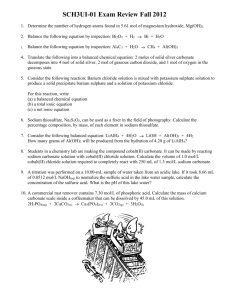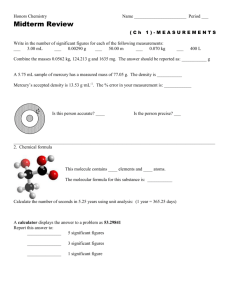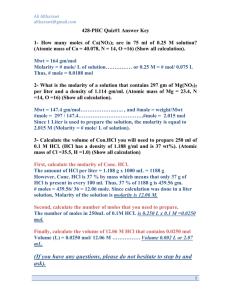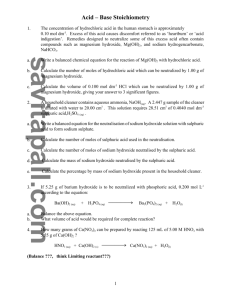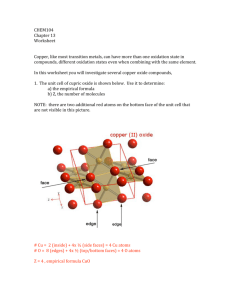practice final exam - NAU jan.ucc.nau.edu web server
advertisement
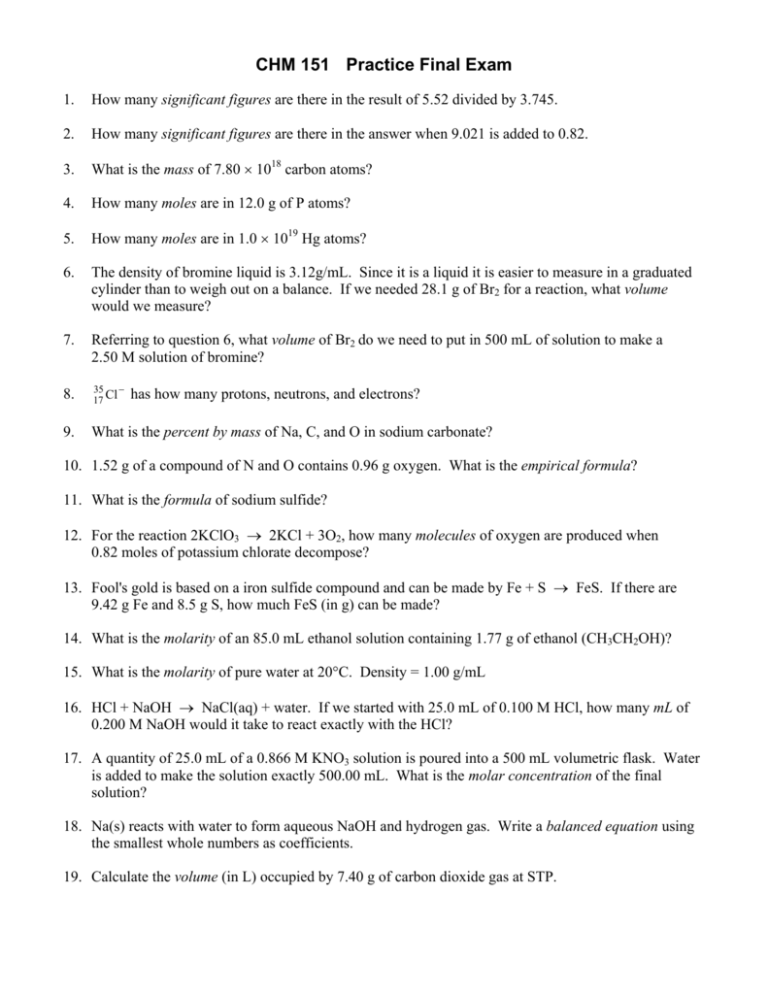
CHM 151 Practice Final Exam 1. How many significant figures are there in the result of 5.52 divided by 3.745. 2. How many significant figures are there in the answer when 9.021 is added to 0.82. 3. What is the mass of 7.80 × 1018 carbon atoms? 4. How many moles are in 12.0 g of P atoms? 5. How many moles are in 1.0 × 1019 Hg atoms? 6. The density of bromine liquid is 3.12g/mL. Since it is a liquid it is easier to measure in a graduated cylinder than to weigh out on a balance. If we needed 28.1 g of Br2 for a reaction, what volume would we measure? 7. Referring to question 6, what volume of Br2 do we need to put in 500 mL of solution to make a 2.50 M solution of bromine? 8. 35 − 17 Cl 9. What is the percent by mass of Na, C, and O in sodium carbonate? has how many protons, neutrons, and electrons? 10. 1.52 g of a compound of N and O contains 0.96 g oxygen. What is the empirical formula? 11. What is the formula of sodium sulfide? 12. For the reaction 2KClO3 → 2KCl + 3O2, how many molecules of oxygen are produced when 0.82 moles of potassium chlorate decompose? 13. Fool's gold is based on a iron sulfide compound and can be made by Fe + S → FeS. If there are 9.42 g Fe and 8.5 g S, how much FeS (in g) can be made? 14. What is the molarity of an 85.0 mL ethanol solution containing 1.77 g of ethanol (CH3CH2OH)? 15. What is the molarity of pure water at 20°C. Density = 1.00 g/mL 16. HCl + NaOH → NaCl(aq) + water. If we started with 25.0 mL of 0.100 M HCl, how many mL of 0.200 M NaOH would it take to react exactly with the HCl? 17. A quantity of 25.0 mL of a 0.866 M KNO3 solution is poured into a 500 mL volumetric flask. Water is added to make the solution exactly 500.00 mL. What is the molar concentration of the final solution? 18. Na(s) reacts with water to form aqueous NaOH and hydrogen gas. Write a balanced equation using the smallest whole numbers as coefficients. 19. Calculate the volume (in L) occupied by 7.40 g of carbon dioxide gas at STP. 20. The density of a gaseous compound is 3.38 g/L at 40°C and 1.97 atm. What is its molar mass? 21. Sodium azide (NaN3) is used in air bags for automobile safety. The impact triggers the decomposition of NaN3 to form nitrogen gas, filling the bag as follows: 2NaN3 → 2Na(s) + 3 N2(g). Calculate the volume of N2 produced at 21°C and 823 mmHg if 60.0 g of sodium azide reacted? 22. All gases at a given temperature travel at the same average velocity. (T or F) 23. If the atmospheric pressure in Flagstaff is 603 mmHg. What is the pressure of O2? O2 is 20.0% of the atmosphere. 24. The ΔHf of any substance in its natural state at standard conditions is always zero. (T or F) 25. Benzene (C6H6) burns in air to produce CO2 and liquid water. Write a balanced equation and calculate the ΔH of the reaction in kJ/mol of benzene reacting with oxygen. ΔHf(Benzene) = 49.04 kJ/mol; ΔHf(CO2) = −393.5 kJ/mol; ΔHf(H2O) = −285.8 kJ/mol. 26. 466 g of water is heated from 8.50°C to 74.60°C. What is the heat absorbed (in kJ) by the water. Specific heat of water = 4.184 J/g.°C 27. Calculate the frequency of red light of wavelength 6.50 × 102 nm. 28. What is the energy of a mole of photons having a wavelength of 700 nm (red light)? 29. Which orbital is filled last in the silver atom? 30. Which atom corresponds to the electron configuration of 1s22s22p63s23p64s23d5? 31. Which atom has the same electronic configuration as Mg2+? 32. Arrange the atoms in order of increasing radius: P, Si, N. 33. Which is largest in size Fe3+ or Fe2+? 34. Which is the most electronegative? P, S or Cl? 35. An ionic bond is typically formed between a metal cation and a non-metal anion. (T or F) 36. An aqueous solution of barium chloride is mixed with an aqueous solution of sodium sulfate. A precipitate forms. Identify the precipitate. 37. Hydrochloric acid [HCl (aq)] is reacted with potassium hydroxide [KOH]. Write the net ionic equation for this reaction. 38. Classify the type of bond in HCl, KF, and the CC bond in C2H4. 39. In the nitrate ion, NO3− , what hybrid orbitals are used by nitrogen in bonding? 40. Molecules with no dipole (no net charge direction) cannot have polar bonds? (T or F) 41. What are the molecular geometries of BH3, CH4, SF5+, BeH2, SF4, H2S, and CO32−? 42. What are the approximate bond angles of the molecules in question 41? 43. How many sigma bonds, pi bonds, and lone pairs are there in H H C H C H 44. Which has the highest first ionization energy O or S? highest 2nd ionization energy Li or Be? 45. The boiling point of I2 is higher than F2 because of what type of intermolecular force? 46. Comparing a polar and a nonpolar molecule with similar molar mass, the polar one always has a higher boiling point. (T or F) 47. Hydrogen bonding is the main intermolecular attraction in ammonia. (T or F) 48. Draw a phase diagram; label all the regions. 49. How many ions does magnesium chloride dissociate into when dissolved in water? 50. Diamond is so hard because it is a covalent-network solid. (T or F) 51. A crystalline solid is hard, has a high melting point, and is a good conductor of electricity when molten. What type of crystalline solid is this? 52. Which of the following substances would be the most soluble in CCl4? CH3CH2OH, H2O, NH3, C10H22. 53. A solution is prepared by dissolving 50.0 g of cesium chloride (CsCl) in 50.0 g of water. The density of the solution is 1.58 g/mL. Calculate the molarity, and molality of the cesium chloride solution. Answers (1) 3; (2) 3; (3) 1.56×10−4g; (4) 0.387mol; (5) 1.7×10−5mol; (6) 9.01mL; (7) 64mL ; (8) 17p,18n,18e; (9) Na=43.4%, C=11.3%, O=45.3%; (10) N2O3; (11) Na2S; (12) 7.4×1023 O2 molecules; (13) 14.8g; (14) 0.452M; (15) 55.5M; (16) 12.5mL; (17) 0.0433M; (18) 2Na+2H2O → 2NaOH+H2; (19) 3.77L; (20) 44.1g/mol; (21) 30.8L; (22) F; (23) 121 mmHg; (24) F; (25) −3267.4 kJ/mol benzene reacted; (26) 129kJ; (27) 4.61 × 1014 Hz (28) 1.71×105J; (29) 4d; (30) Mn; (31) Ne; (32) N<P<Si; (33) Fe2+; (34) Cl; (35) T; (36) BaSO4, barium sulfate; (37) H+ + OH− → H2O; (38) polar covalent, ionic, covalent; (39) sp2; (40) F; (41) trig. planar, tetrahedral, trig. bipyr., linear, distorted tetrahedron (see-saw), bent, trigonal planar; (42) 120°,109.5°,90/120°, 180°, 90/120°, 109°, 120°; (43) 5 sigma, 1 pi, 0 LP; (44) O, Li; (45) dispersion forces; (46) T; (47) T; (48) page 471 Chang; (49) 3; (50) T; (51) ionic solid; (52) C10H22; (53) 4.69 M, 5.94 m
